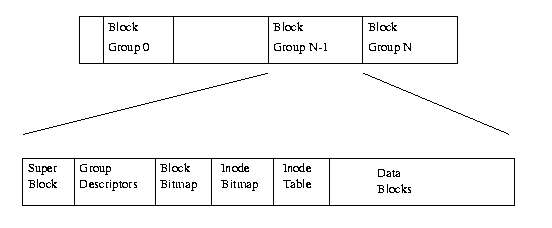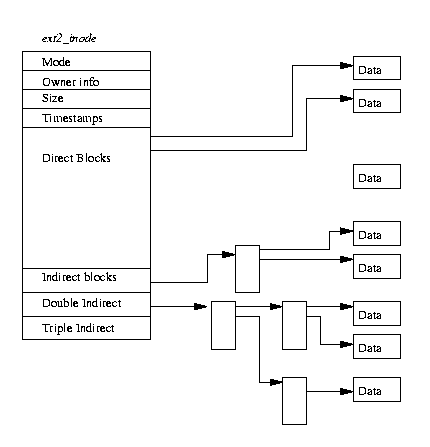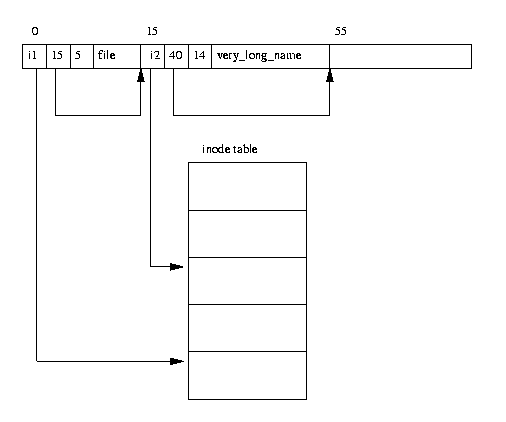The Second Extended File system (EXT2)

The Second Extended File system was devised (by Rémy Card) as an extensible and powerful file system for Linux. It is also the most successful file system so far in the Linux community and is the basis for all of the currently shipping Linux distributions.
The EXT2 file system, like a lot of the file systems, is built on the premise that the data held in files is kept in data blocks. These data blocks are all of the same length and, although that length can vary between different EXT2 file systems the block size of a particular EXT2 file system is set when it is created (using mke2fs). Every file's size is rounded up to an integral number of blocks. If the block size is 1024 bytes, then a file of 1025 bytes will occupy two 1024 byte blocks. Unfortunately this means that on average you waste half a block per file. Usually in computing you trade off CPU usage for memory and disk space utilisation. In this case Linux, along with most operating systems, trades off a relatively inefficient disk usage in order to reduce the workload on the CPU. Not all of the blocks in the file system hold data, some must be used to contain the information that describes the structure of the file system. EXT2 defines the file system topology by describing each file in the system with an inode data structure. An inode describes which blocks the data within a file occupies as well as the access rights of the file, the file's modification times and the type of the file. Every file in the EXT2 file system is described by a single inode and each inode has a single unique number identifying it. The inodes for the file system are all kept together in inode tables. EXT2 directories are simply special files (themselves described by inodes) which contain pointers to the inodes of their directory entries.
Figure 9.1 shows the layout of the EXT2 file system as occupying a series of blocks in a block structured device. So far as each file system is concerned, block devices are just a series of blocks that can be read and written. A file system does not need to concern itself with where on the physical media a block should be put, that is the job of the device's driver. Whenever a file system needs to read information or data from the block device containing it, it requests that its supporting device driver reads an integral number of blocks. The EXT2 file system divides the logical partition that it occupies into Block Groups.
Each group duplicates information critical to the integrity of the file system as well as holding real files and directories as blocks of information and data. This duplication is neccessary should a disaster occur and the file system need recovering. The subsections describe in more detail the contents of each Block Group.
The EXT2 Inode

In the EXT2 file system, the inode is the basic building block; every file and directory in the file system is described by one and only one inode. The EXT2 inodes for each Block Group are kept in the inode table together with a bitmap that allows the system to keep track of allocated and unallocated inodes. Figure 9.2 shows the format of an EXT2 inode, amongst other information, it contains the following fields:
- mode
- This holds two pieces of information; what this inode describes and the permissions that users have to it. For EXT2, an inode can describe one of file, directory, symbolic link, block device, character device or FIFO.
- Owner Information
- The user and group identifiers of the owners of this file or directory. This allows the file system to correctly allow the right sort of accesses,
- Size
- The size of the file in bytes,
- Timestamps
- The time that the inode was created and the last time that it was modified,
- Datablocks
- Pointers to the blocks that contain the data that this inode is describing. The first twelve are pointers to the physical blocks containing the data described by this inode and the last three pointers contain more and more levels of indirection. For example, the double indirect blocks pointer points at a block of pointers to blocks of pointers to data blocks. This means that files less than or equal to twelve data blocks in length are more quickly accessed than larger files.
The EXT2 Superblock
The Superblock contains a description of the basic size and shape of this file system. The information within it allows the file system manager to use and maintain the file system. Usually only the Superblock in Block Group 0 is read when the file system is mounted but each Block Group contains a duplicate copy in case of file system corruption. Amongst other information it holds the:- Magic Number
- This allows the mounting software to check that this is indeed the Superblock for an EXT2 file system. For the current version of EXT2 this is 0xEF53.
- Revision Level
- The major and minor revision levels allow the mounting code to determine whether or not this file system supports features that are only available in particular revisions of the file system. There are also feature compatibility fields which help the mounting code to determine which new features can safely be used on this file system,
- Mount Count and Maximum Mount Count
- Together these allow the system to determine if the file system should be fully checked. The mount count is incremented each time the file system is mounted and when it equals the maximum mount count the warning message ``maximal mount count reached, running e2fsck is recommended'' is displayed,
- Block Group Number
- The Block Group number that holds this copy of the Superblock,
- Block Size
- The size of the block for this file system in bytes, for example 1024 bytes,
- Blocks per Group
- The number of blocks in a group. Like the block size this is fixed when the file system is created,
- Free Blocks
- The number of free blocks in the file system,
- Free Inodes
- The number of free Inodes in the file system,
- First Inode
- This is the inode number of the first inode in the file system. The first inode in an EXT2 root file system would be the directory entry for the '/' directory.
The EXT2 Group Descriptor
Each Block Group has a data structure describing it. Like the Superblock, all the group descriptors for all of the Block Groups are duplicated in each Block Group in case of file system corruption.Each Group Descriptor contains the following information:
- Blocks Bitmap
- The block number of the block allocation bitmap for this Block Group. This is used during block allocation and deallocation,
- Inode Bitmap
- The block number of the inode allocation bitmap for this Block Group. This is used during inode allocation and deallocation,
- Inode Table
- The block number of the starting block for the inode table for this Block Group. Each inode is represented by the EXT2 inode data structure described below.
- Free blocks count, Free Inodes count, Used directory count
EXT2 Directories

In the EXT2 file system, directories are special files that are used to create and hold access paths to the files in the file system. Figure 9.3 shows the layout of a directory entry in memory.
A directory file is a list of directory entries, each one containing the following information:
- inode
- The inode for this directory entry. This is an index into the array of inodes held in the Inode Table of the Block Group. In figure 9.3, the directory entry for the file called file has a reference to inode number i1,
- name length
- The length of this directory entry in bytes,
- name
- The name of this directory entry.
Tidak ada komentar:
Posting Komentar